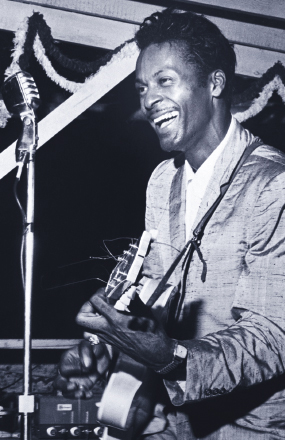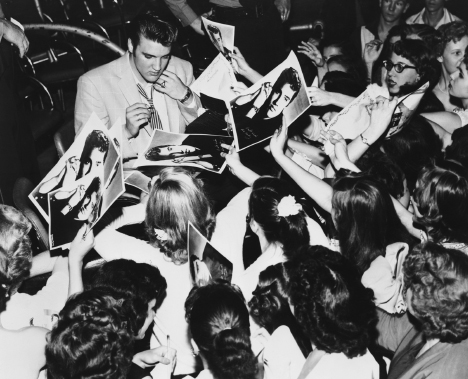Rock Blurs Additional Boundaries
Printed Page 139
While rock and roll was molded by powerful social, cultural, and political forces, it also shaped them in return. As we’ve seen, it began blurring the boundaries between black and white. But it broke down additional divisions as well—between high and low culture, masculinity and femininity, country and city, North and South, and the sacred and the secular.

High and Low Culture
Rock challenged the long-standing distinction between high and low culture initially through its lyrics and later through its performance styles. In 1956, Chuck Berry’s song “Roll Over Beethoven” merged rock and roll (which many people considered low culture) with high culture through lyrics that included references to classical music: “You know my temperature’s risin’ / the jukebox is blowin’ a fuse. . . . Roll over Beethoven / and tell Tchaikovsky the news.” Rock artists also defied norms governing how musicians should behave: Berry’s “duck walk” across the stage, Elvis Presley’s tight pants and gyrating hips, and Bo Diddley’s use of the guitar as a phallic symbol shocked elite audiences—and inspired additional antics by subsequent artists.
Masculinity and Femininity
Rock and roll was also the first pop-music genre to overtly challenge assumptions about sexual identity and orientation. Although early rock and roll largely attracted males as performers, the most fascinating feature of Elvis Presley, according to the Rolling Stones’ Mick Jagger, was his androgynous appearance.3 Little Richard (Penniman) took things even further, sporting a pompadour hairdo, decorative makeup, and feminized costumes during his performances.4
Country and City
Rock and roll also blended cultural borders between black urban rhythms and white country & western music. Early white rockers such as Buddy Holly and Carl Perkins combined country or hillbilly music, southern gospel, and Mississippi delta blues to create a sound called rockabilly. Conversely, rhythm and blues spilled into rock and roll. Many songs such as “Rocket 88,” first popular on R&B labels, crossed over to the pop charts during the mid to late 1950s, though many of these songs were performed by more widely known white artists.
Rock lyrics in the 1950s may not have been especially provocative or overtly political by today’s standards. But soaring record sales and the crossover appeal of the music itself represented an enormous threat to long-standing racial and class divisions defined by geography. Distinctions between traditionally rural white music and urban black music dissolved, as some black artists (like Chuck Berry) strived to “sound white” to attract Caucasian fans, and some white artists (such as Elvis Presley) were encouraged by record producers to “sound black.”

North and South
Not only did rock and roll blur the line between urban and rural, it also mixed northern and southern influences together. As many blacks migrated north during the early twentieth century, they brought their love of blues and R&B with them. Meanwhile, musicians and audiences in the North had claimed blues music as their own, forever extending its reach beyond its origins in the rural South. Some white artists from the South—most notably Carl Perkins, Elvis Presley, and Buddy Holly—further carried southern musical styles to northern listeners.
Sacred and Secular
Many mainstream adults in the 1950s complained that rock and roll’s sexual overtones and gender-bending constituted an offense against God—even though numerous early rock figures (such as Elvis Presley, Jerry Lee Lewis, and Little Richard) had strong religious upbringings. In the late 1950s, public outrage over rock proved so great that even Little Richard and Jerry Lee Lewis, both sons of southern preachers, became convinced that they were playing the “devil’s music.” Throughout the rock era and even today, boundaries between the sacred and secular continue to blur through music. For example, some churches are using rock and roll to appeal to youth, and some Christian-themed rock groups are recording in seemingly incongruous musical styles, such as heavy metal.